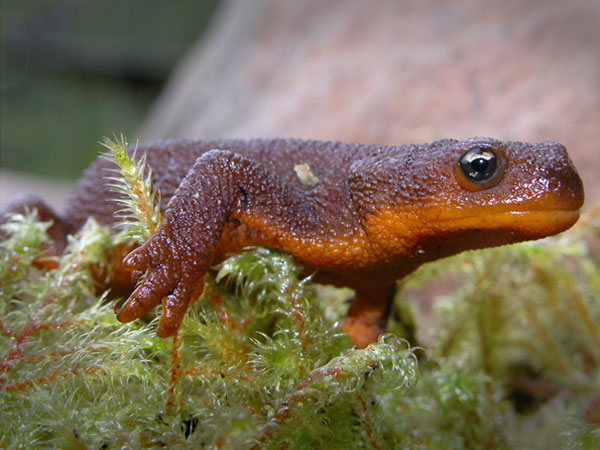Interesting Facts About the Rough-skinned Newt
Interesting Reproductive Features and Adaptations
In reproduction the
Rough-skinned Newt or Tarica granulosa undergoes a very
unique reproductive “ritual.” The ritual begins with females
gathering in a small body of water such as a pond, shortly after
a much larger number of males frantically enter the water in
search of a female. Many males will group around one female
essentially wrestling with one another over mating for the
female until finally the female chooses one male (California
Herps 2013). Prior to the rough skinned newt “orgy” the Male
newt develops a smother skin, and swollen cloaclal lips, he also
develops padding on his feet and digits in order to assist in
gripping the female during reproduction (California
Herps 2013). Females undergo very slight changes in their
appearance in comparison to males; the female develops only a
slightly smoother skin. All reproduction is undergone in an
aquatic environment. Interestingly the same tetrodotoxin or for
short TTX, is found within the adult Rough-skinned Newt is also
present in the eggs produced by Taricha granulosa (California
Herps 2013). Taricha granulosa tends to breed and
lay eggs in shallow streams and ponds, near the edge of the body
of water, and close to vegetation (California
Herps 2013). This is presumed to deal with the dangers of
rough waters to prevent the eggs from tumbling down a fast
moving river, and also to breed close to the location where eggs
would be placed. The eggs are quite often attached to sticks, or
vegetation as an anchor to prevent them from free-floating (California
Herps 2013). An interesting behavioral adaptation relating
to the reproductive behaviors of the Rough-skinned Newt was
noted that the male newt will actually inhibit sexual drive when
placed under enough stress by predators and other factors (Moore,
Miller, 1984).
Interesting Defensive Mechanism
Interestingly the Rough-skinned Newt
becomes almost entirely aquatic when preparing to breed or
undergoing breeding. One might find it intriguing that separate
populations of Taricha granulosa exhibit very different
life styles, in certain areas populations have been known to
become nocturnal, and others primarily aquatic as opposed to
terrestrial which is the norm for the Rough-skinned Newt. During
fall in most terrestrial populations, rain-fall will trigger the
newt to begin wandering f orage
(California Herps 2013).
orage
(California Herps 2013).
The Rough-skinned Newt as evolved a defense mechanism
utilizing both poison and bright
colors. When in danger the newt curls its head and teal back
towards each other. What this does is warn predators that the
newt is poisonous and should not be eaten. During this time the
newt also begins excreting toxins onto the surface of its own
skin (California Herps 2013). The
poison within the newt is known as a tetrodotoxin or TTX, this
is a neurotoxin that will cause death in most animals, and
including humans. The toxin can be dangerous through
consumption, ingestion through a mucous membrane, or even
through a cut. This toxin is so potent, it could kill as many as
25,000 mice from just one newt. However the toxin is not enough
to completely protect the newt from predation, the garter snake
is very resistant to this toxin and preys upon the Rough-skinned
Newt (California Herps 2013). Oddly
enough some research suggests that juvenile Rough-skinned Newts
possess very little amounts of TTX compared to an adult
Rough-skinned Newt and that larval stages actually do not
contain TTX or very small amounts of TTX (Gall,
B.G, et. al 2011).
Interesting Lifestyle Choices
Populations of newts have been known
to become aquatic for![]() months, even years at a time; this is very uncommon for most
newts (California Herps 2013).
Finding a newt in the water is nothing unusual, like finding a
newt wandering the land. However observing a newt spend its
entire life, or a huge portion of its life only in the water is
commonly found to be rather unusual in amphibians as a whole.
Amphibians may spend a large amount of time in the water but
most do not only spend large sums of time only as an aquatic
animal. It is known that populations very from location to
location that some exhibit more nocturnal lifestyles, some
exhibit completely aquatic, and others mostly terrestrial (California
Herps 2013).
months, even years at a time; this is very uncommon for most
newts (California Herps 2013).
Finding a newt in the water is nothing unusual, like finding a
newt wandering the land. However observing a newt spend its
entire life, or a huge portion of its life only in the water is
commonly found to be rather unusual in amphibians as a whole.
Amphibians may spend a large amount of time in the water but
most do not only spend large sums of time only as an aquatic
animal. It is known that populations very from location to
location that some exhibit more nocturnal lifestyles, some
exhibit completely aquatic, and others mostly terrestrial (California
Herps 2013).
Why did I choose this organism?
My group and I chose this
organism for a combination of several factors. But the most
prevalent reasons were access to research already done on the
organism, and the other being an overwhelming interest in a
poisonous skinned newt that gets in on orgies underwater. While
also finding it to be an odd organism for several reasons such
as the orgy and that an organism will intentionally make itself
extremely vulnerable as a defense mechanism.
What is interesting about its relatives?
What I find extremely interesting about salamanders
is the convergent evolution with that of lizards in terms of
body shape and movement on land, and in some cases in water.
I’ve always found lizards to be quite interesting so why not
look at newts and salamanders for a change.